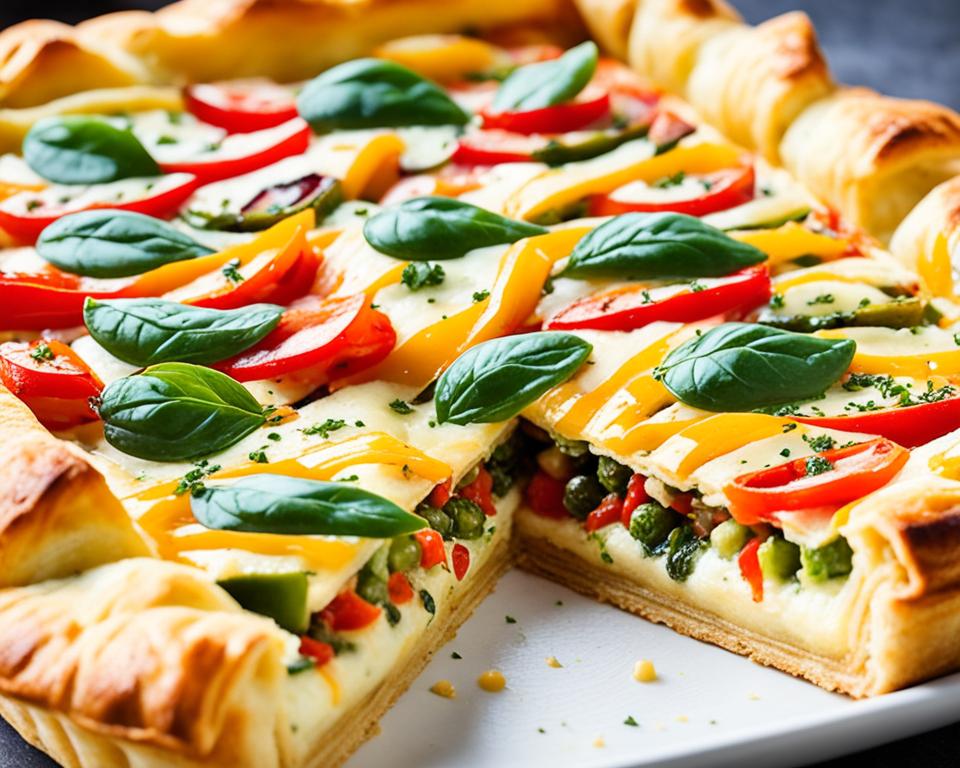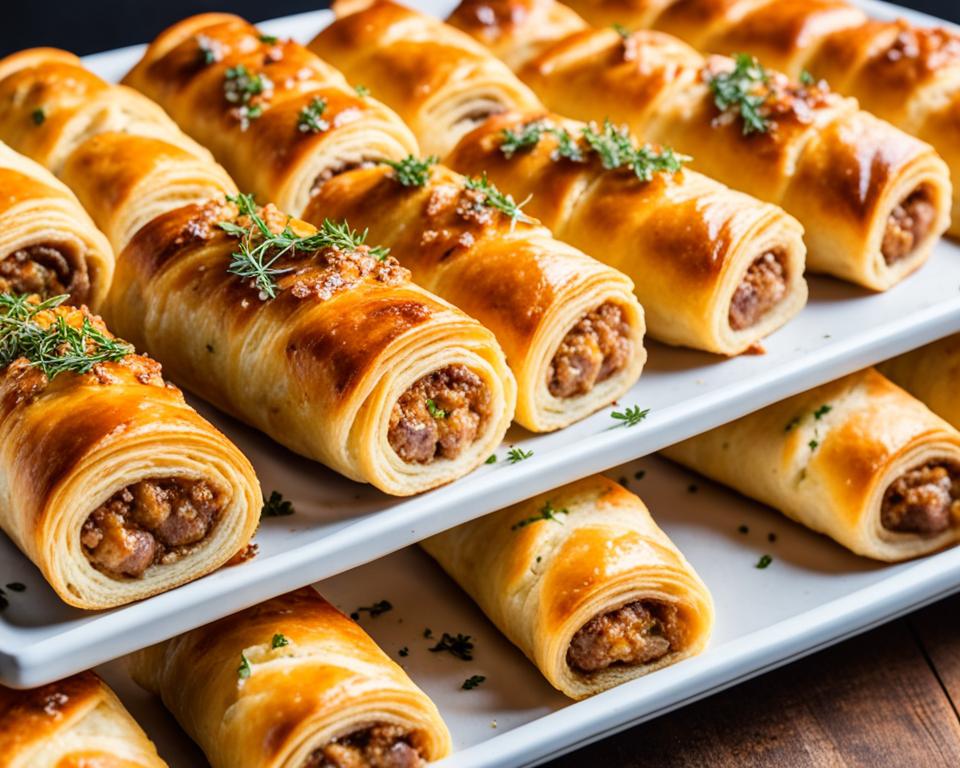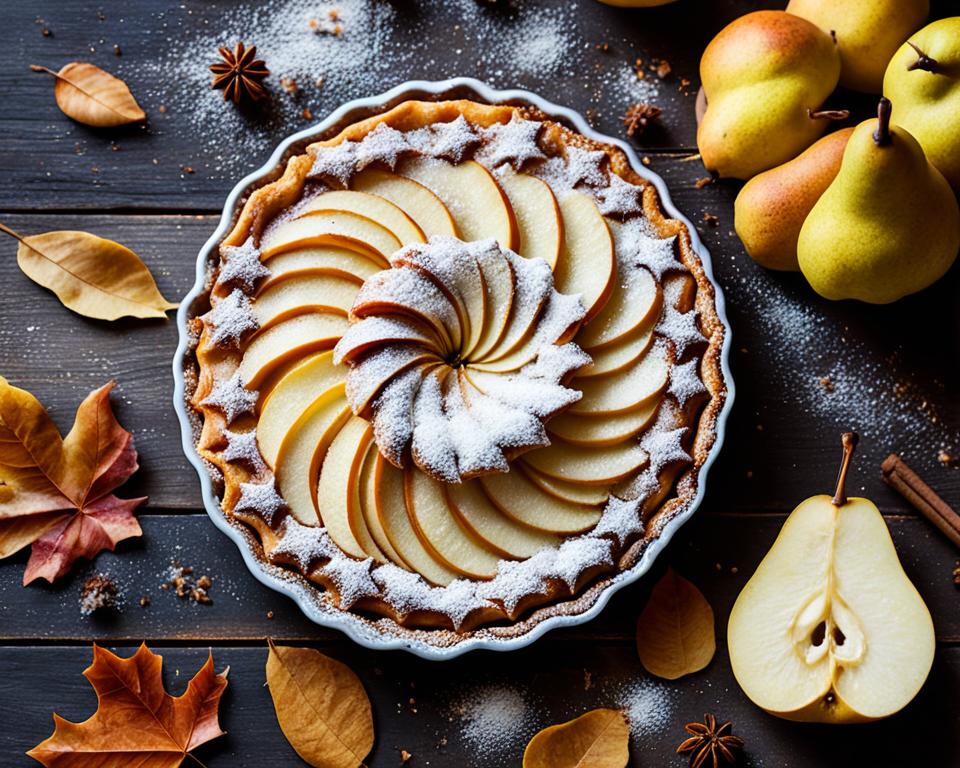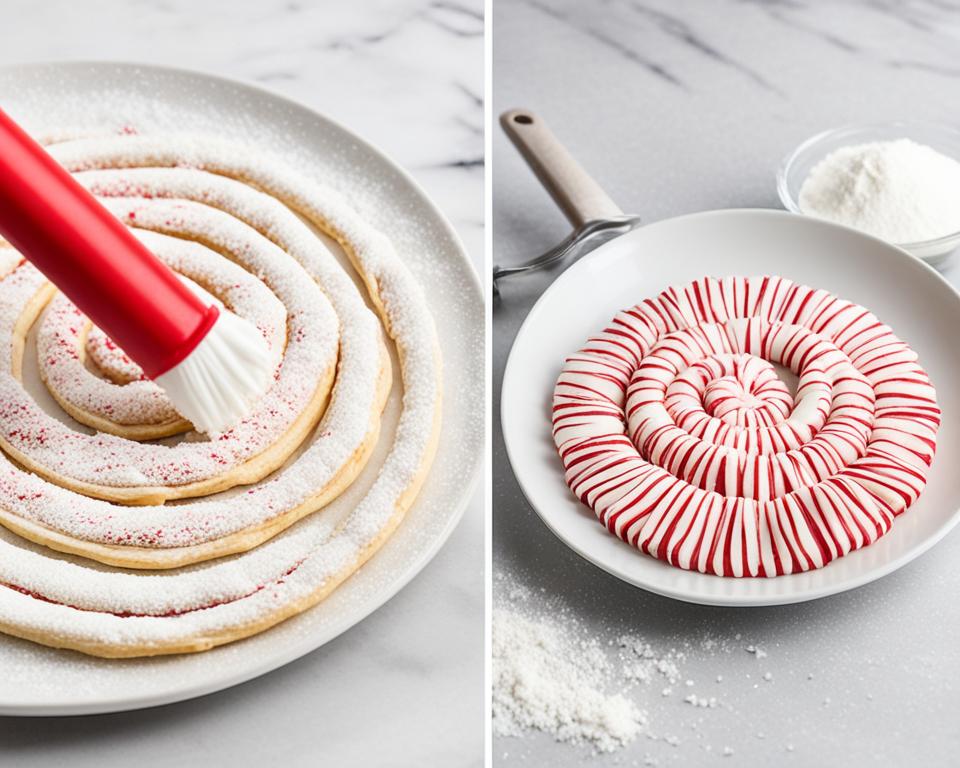Embarking on a journey of creating a homemade pastry from scratch reveals the true craft behind those delicious pastries found in high-end bakeries. Venturing beyond the convenience of store-bought options, home bakers can achieve a perfect flaky puff pastry with an easy puff pastry recipe. This intermediate baking endeavor strips down the complexities traditionally associated with puff pastry, giving rise to a more approachable yet equally indulgent result. With patience and attention to detail, anyone can elevate their baking repertoire by mastering this foolproof method.
Whether one desires to craft savory dishes or sweet confections, the versatility of a well-made flaky puff pastry is unmatched. The satisfaction that comes from peeling apart the light, airy layers of a pastry made by one’s own hands is a delightful reward for the time and effort invested. By following a few key techniques, home bakers can transform simple ingredients into a delightful array of homemade pastry masterpieces that are as beautiful as they are delicious.
Key Takeaways
- The “rough puff” technique simplifies puff pastry, eliminating the need for yeast and intricate laminating.
- Cold ingredients are crucial for achieving a flaky texture and avoiding premature butter melting.
- Homemade recipes allow for flexible scheduling with options for overnight chilling or freezing.
- An easy puff pastry recipe is within reach of home bakers, enhancing both sweet and savory dishes.
- Attention to the folding process promises the perfect layers associated with high-quality pastries.
- Home baking of flaky puff pastry adds a personal touch and unsurpassed taste to culinary creations.
Understanding the Basics of Flaky Puff Pastry
Delving into the art of homemade pastry creation uncovers the versatility of the flaky pastry dough. One particular technique, the rough puff method, streamlines the process without compromising on the quality of those coveted buttery layers. Revered cookbook author Claire Saffitz’s advocacy for this method underlines its growing popularity among pastry enthusiasts.
The “Rough Puff” Method Explained
Traditional puff pastry often intimidates even seasoned bakers due to its time-consuming lamination process. However, the ‘rough puff’ simplifies these intricacies. It emphasizes incorporating large, cold butter pieces into the flour and then hydrating the mix with ice water. This careful integration is key to forming layer upon layer of pastry perfection, resulting in exquisite homemade pastries that boast both taste and texture.
Why Temperature is Key to Flakiness
Temperature plays the starring role in achieving the distinct flakiness of puff pastry. Working with cold butter ensures that it doesn’t meld into the flour during the kneading process. Instead, it remains distinct, melting only in the oven’s heat to create the steam that magically transforms the dough into flaky pastry dough.
The Role of Butter in Achieving Perfect Layers
The foundation of unforgettable, flaky pastry lies within its buttery stratums. Avoiding over-processing tools like food processors, bakers utilize tactile skill to preserve the integrity of the butter chunks. This crucial aspect guarantees that once it reaches the high temperatures of the oven, the butter provides the necessary separation within the dough, culminating in irresistibly light and buttery layers.
Step-by-Step Guide to the Perfectly Flaky Puff Pastry
The creation of a buttery, homemade pastry reminiscent of the classics from famed pâtisseries starts with precision and patience. This easy puff pastry recipe will provide bakers with a step-by-step guide to achieving those airy, flaky puff pastry textures, elevating their home baking to a professional standard.
- Mixing the Dough: Begin by whisking together the dry ingredients in a large bowl. Add your chilled, cubed butter, gently tossing it with the flour without breaking the butter down too much.
- Hydrating the Dough: Gradually introduce ice-cold water, using your hands to mix until the dough just begins to come together in a shaggy form, careful not to overwork it, thereby preserving the all-important butter chunks.
- First Folding: Once combined, flatly lay the dough onto a lightly floured surface. Pat it down and fold it like a letter. This is your first business letter fold.
- Rolling Out the Dough: After the dough has rested, roll it out into a rectangle before performing another business letter fold. This step is repeated six times, with no rest required between each fold.
- Final Chill: Tightly wrap your dough and place it in the fridge for a short cooling period to set the layers before using.
The sequence of rolling and folding, ideally facilitated by a rolling pin on a well-floured surface, is integral to developing the pastry’s buttery layers. With each turn and fold, home bakers inch closer to the quintessential flaky puff pastry that forms the basis for countless decadent baked goods.
| Step | Technique | Notes |
|---|---|---|
| 1. Mix Ingredients | Toss cubed butter with flour | Keep the butter cold for flakiness |
| 2. Hydrate Dough | Add ice-cold water gradually | Do not over-mix; form a shaggy dough |
| 3. First Fold | Business letter folding technique | Begin layering the dough |
| 4. Roll & Fold | Roll out & fold dough six times | Creates numerous delicate layers |
| 5. Final Chill | Refrigerate the dough | Rest to set layers before use |
Following these steps results in a pastry that transforms through the baking process, as the cold pieces of butter expand with heat to create steam, meticulously separating the dough into buttery layers. A technique hailing from classic European traditions, yet simplified for the modern baker, offers gratifying results that transcend the simplicity of its making.
Whether they plan to wrap a savory filling for a hearty dinner or craft the base for a sweet, fruit-laden tart, this guide assists bakers in bringing a touch of the artisanal into the heart of their home kitchens. They will marvel at the ease with which the homemade pastry peels into delightful, flaky layers, a testament to the baker’s deft handiwork.
Choosing the Right Ingredients for Your Pastry
Creating the perfect pastry recipe begins with selecting premium ingredients that work cohesively to produce the sumptuous layers of a flaky puff pastry. The quality and temperature of each component drastically influence the texture, flavor, and overall success of your homemade pastry. Understanding the characteristics of these ingredients enhances the effectiveness of the pastry-making process, setting the stage for a truly exceptional baking outcome.
The Importance of Using Cold, Quality Butter
When it comes to making a standout homemade pastry, the type of butter used cannot be overlooked. High-fat, European-style butter is often favored by professionals for its superior melting qualities, which are essential for achieving that enviable flakiness in the pastry layers. It must be kept cold, so the butter melts precisely in the oven where it belongs, creating pockets of steam that lift and separate the dough into feather-light sheets.
The Difference High-Quality Flour Makes
Following butter, the backbone of any puff pastry is the flour. Opting for high-quality flour ensures a stable structure that can withstand the intricate folding necessary for layering. Moreover, it absorbs the right amount of water and binds with fat at an optimal ratio, preventing the pastry from becoming too dense or too brittle. This delicate balance is what gives the pastry its signature tender, yet crisp texture.
To further exemplify the importance of ingredient quality, consider the table below. It contrasts the outcomes when using standard ingredients versus high-quality ones. The results are telling; quality not only influences the experience of eating the pastry but also the process of making it.
| Ingredient | Standard Quality Outcome | High-Quality Outcome |
|---|---|---|
| Butter | Increased greasiness, less distinct layers | Defined layers, superior flakiness |
| Flour | Inconsistent texture, potential toughness | Consistent texture, tender and crisp |
| Water | Possible gluten overdevelopment | Controlled hydration, preserving butter integrity |
Approaching the ingredient selection with discernment allows bakers to craft a homemade pastry that rivals those found in artisanal shops and pâtisseries. It is this attention to detail and dedication to quality that transforms a simple recipe into an exquisite, flaky masterpiece.
Flaky Puff Pastry from Scratch Without Yeast
Forgoing the complexity and time required for yeast-based pastries, bakers can indulge in a simpler, more immediate process of creating flaky puff pastry at home. This yeast-free pastry leans on the principles of mechanical layering and the steam-driven puff, which is integral to obtaining a beautifully textured pastry. The result is a versatile dough that’s idyllic for an array of applications, from buttery breakfast pastries to savory dinner staples.
One need not be a professional chef to achieve bakery-quality results; this easy puff pastry recipe is designed for a hassle-free baking experience. Emphasizing the use of cold, quality butter and meticulous temperature management, this straightforward method yields a homemade pastry that holds its own against any high-end bakery offer. Perfect for those looking to replace store-bought sheets, the homemade version promises a noticeable upgrade in both texture and flavor.
Here’s a comparative look at why opting for a homemade yeast-free pastry trumps the common store-bought versions, with insights into the characteristics that make this recipe outstanding:
| Characteristic | Store-Bought Pastry | Homemade Yeast-Free Pastry |
|---|---|---|
| Texture | Often uniformly layered but can lack distinct flakiness | Noticeably flaky, airy, with buttery layers that meld harmoniously |
| Taste | Neutral, sometimes with preservatives or additives | Buttery, rich, with the pure taste of quality ingredients |
| Freshness | Dependent on packaging and preservatives | Exceptionally fresh, with no need for additives |
| Versatility | Constrained by flavor and texture profiles | Optimal for both sweet and savory dishes, adaptable to personal taste |
Whether they are a novice or a seasoned baker, one can achieve gratifying success with this easy puff pastry recipe. The satisfaction of peeling through the homemade pastry‘s countless flaky layers, each bite a testament to the quality of your craftsmanship, is a joy unmatched by premade alternatives.
The Secret to Laminating Puff Pastry Like a Pro
Discovering the art of laminating puff pastry is a game-changer in baking, allowing you to create flaky pastry dough that rivals professional pastries. Professional baking techniques heavily emphasize the importance of handling the dough with precision and protecting the butter from becoming too warm, which can complicate the layering process and affect the final product’s quality.
How to Properly Fold Your Dough
To achieve those illustrious buttery layers in a puff pastry, one must master the art of folding. The process starts by grating cold butter directly into the flour mixture. This ensures even distribution and maintains the butter’s temperature, providing a shortcut to the texture we crave. When folding the dough, use deliberate but gentle motions to stack the layers without compressing them, allowing the pastry to retain its lofty rise.
Why Overworking the Dough is a Pitfall to Avoid
The biggest threat to the delicate structure of puff pastry is overworking the dough. Too much manipulation can cause the butter to smear into the flour, leading to a dough that bakes into a dense mass rather than a light, expansive pastry. Therefore, a light touch and minimal processing are keys to success. By handling the dough just enough to bring it together before it rests, you set the stage for a final product that boasts the perfect pastry texture—crisp, flaky, and utterly divine.
The process of creating puff pastry at home may seem daunting, but with these techniques and a careful hand, any baker can turn out pastries that look as though they’ve come straight from the display case of the finest patisserie. Whether it’s for sweet turnovers or savory vol-au-vents, these professional baking techniques for laminating puff pastry give you the prowess to elevate your baking creations to a whole new level of excellence.
Flaky Pastry Dough: Rolling and Folding Techniques
The transformation of basic ingredients into a flaky pastry dough hinges on meticulous rolling and folding techniques. Much like the detailed folds of a business letter fold, each motion contributes to the dough’s final airy texture, integral to a homemade pastry. To ensure success, one must exhibit precision and cautious handling, particularly in maintaining the dough’s chill to prevent the butter from melding prematurely into the dough. A cold work surface and a dusting of flour are allies in this process, promising a dough robust with layers, primed for a range of culinary adventures.
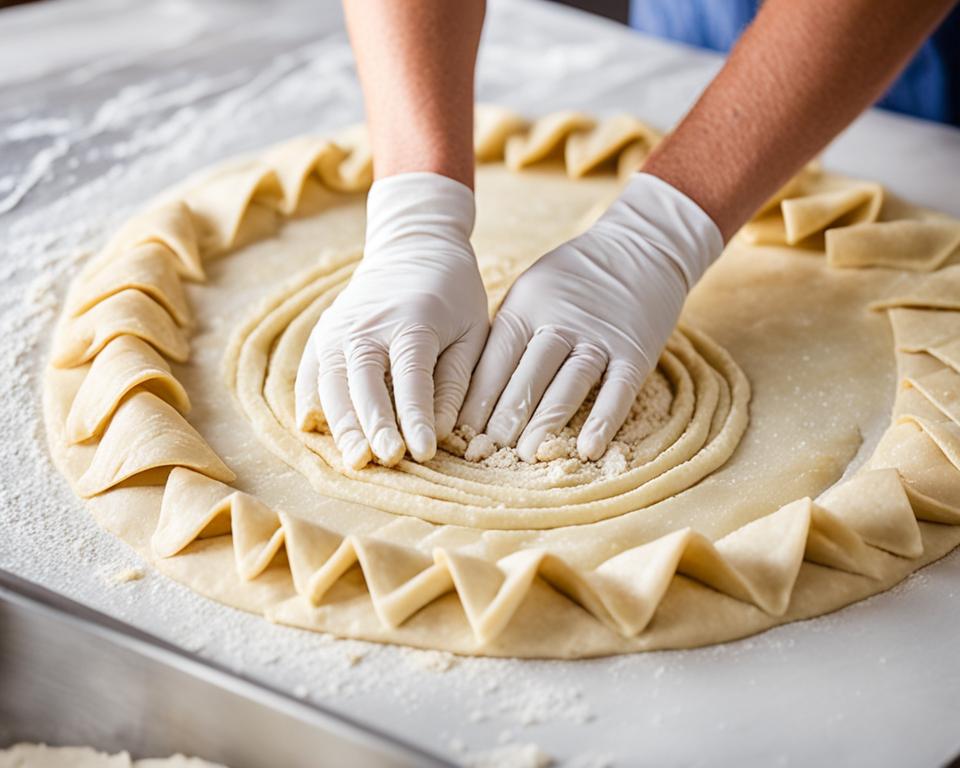
Creating Layers with the Business Letter Fold
The business letter fold is an essential technique in developing the quintessential structure of flaky pastry dough. Imagine folding a letter: the dough is rolled out into a rectangle, which is then folded into thirds, much like tucking a letter into an envelope. This physical incorporation of air pockets is what bestows our homemade pastry with its characteristic puffiness upon baking. With each fold, layer upon layer of buttery goodness is enveloped in the supple dough, ensuring that divine flakiness is achieved.
Maintaining the Dough’s Temperature During Processing
A critical aspect of crafting the perfect flaky pastry dough lies in the temperature control during its creation. A pastry slab, the board on which the dough is rolled, often remains cool, aiding in maintaining the desired consistency as the dough is worked. Throughout the rolling and folding process, if at any point the dough begins to warm and stick, a brief sojourn in the fridge will resurrect its workability. Achieving the artisanal texture of the dough demands discipline, simply by ensuring the elements of the pastry remain cool until the very moment they graces the oven’s warmth.
Cooling Requirements for Puff Pastry Perfection
Embarking on the creation of a homemade pastry as sumptuous as a flaky puff pastry necessitates an understanding of the key cooling requirements. Integral to the process are the chilling stages that come between each roll and fold, acting as quality checkpoints ensuring the buttery layers maintain their distinct character.
The chilling process begins immediately after the dough is mixed. This initial step, carrying immense importance, stabilizes the butter within, reinforcing it against the rigors of rolling. Precision in cooling times ensures that as the dough is folded and rolled, it remains pliant without allowing the butter to warm to pliability—the nemesis of flakiness.
Continued cooling between foldings permits the dough to relax—which is essential in preventing gluten overdevelopment—while retaining the butter’s firmness. It is this disciplined alternation between manipulation and refrigeration that crafts the essence of a homemade pastry‘s delicate structure.
| Stage | Cooling Requirement | Impact on Pastry |
|---|---|---|
| Initial Dough Mixture | Refrigeration after mixing | Firms butter, preventing melding |
| Intermediate Folding | Chilling between each fold | Relaxes gluten, maintains butter form |
| Pre-Baking | Final refrigeration to stabilize layers | Solidifies structure for oven’s heat |
As the last step pre-baking, a crucial refrigeration solidifies the now-meticulously formed layers, a last defense that ensures in the heat of the oven, each layer gloriously separates to achieve the peak crispy, airy structure. The cooling requirements therefore are as pivotal as any ingredient in your pastry recipe—improper chilling and the sought-after lightness of the flaky puff pastry may well dissipate like steam in an oven.
These chilling steps, while methodically extending the process, usher forth the patisserie-worthy buttery layers and distinguish a remarkable homemade pastry from the mediocre. Thus, the cooling requirements are not simply suggestions but commandments written in the book of pastry perfection.
From Dough to Delicious: Baking Your Flaky Puff Pastry
The journey from dough to a baking puff pastry masterpiece is a symphony of precision and patience. It begins with preheating, the gateway to the oven’s alchemy where butter transforms into steam, gifting the dough with its iconic flaky puff pastry structure. Let’s guide the pastry through this crucial phase to ensure each batch turns out as delicious pastries reminiscent of a seasoned baker’s handiwork.
Preheating and Baking Temperatures
Preheating your oven is a non-negotiable step in the pastry baking equation. Achieving the perfect temperature allows the pastry to cook evenly and discourages the butter from leaking out before it has had a chance to steam. This steam is what puffs the pastry, creating the layers of air pockets that define a flaky puff pastry. For most puff pastry recipes, preheating to approximately 400 degrees Fahrenheit (205 degrees Celsius) sets the stage for pastry excellence. This high initial temperature kick starts the creation of steam, propelling the pastry to puff quickly and minimizing the risk of the butter saturating the dough and inhibiting rise.
Visual Cues for Perfectly Baked Pastry
While baking temperatures wield the magic, visual cues are the reliable signals that foretell the readiness of your pastry. A golden-brown hue is the hallmark of a perfectly baked puff pastry, signifying that it’s time to remove your delicious creations from the oven. Observing the pastry’s transformation in the oven – from flat dough to puffed, layered delight – is both a chef’s joy and an indicator of success. Other signs of perfect doneness include a crisp, flaky surface that resounds with the softest touch and a structure that stands proud with airiness and lightness.
In summary, baking the perfect puff pastry to achieve that delicious pastries result lies in meticulously controlled preheating and baking temperatures. Set your oven correctly, watch for those telling cues indicating perfect puffiness and color, and you’ll open the door to a world where each pastry is a flaky treasure.
| Preheating Temperature | Visual Cues | Expected Outcome |
|---|---|---|
| 400°F (205°C) | Golden-brown color | Perfectly baked, flaky pastry |
| Check Oven Calibration | Pastry puffs up | Evenly cooked dough |
| Follow Recipe Guidelines | Crisp surface | Distinguished layers |
Tips for Preserving the Flaky Texture Post-Baking
After meticulously preparing a homemade puff pastry, it’s crucial to preserve its distinctive flaky texture once baking is complete. Proper storage techniques can extend the pastry’s delight for days, keeping it as airy and crispy as when it first came out of the oven. To maintain the magic of your culinary creation, adhere to these essential pastry tips that will prevent common setbacks in puff pastry storage.
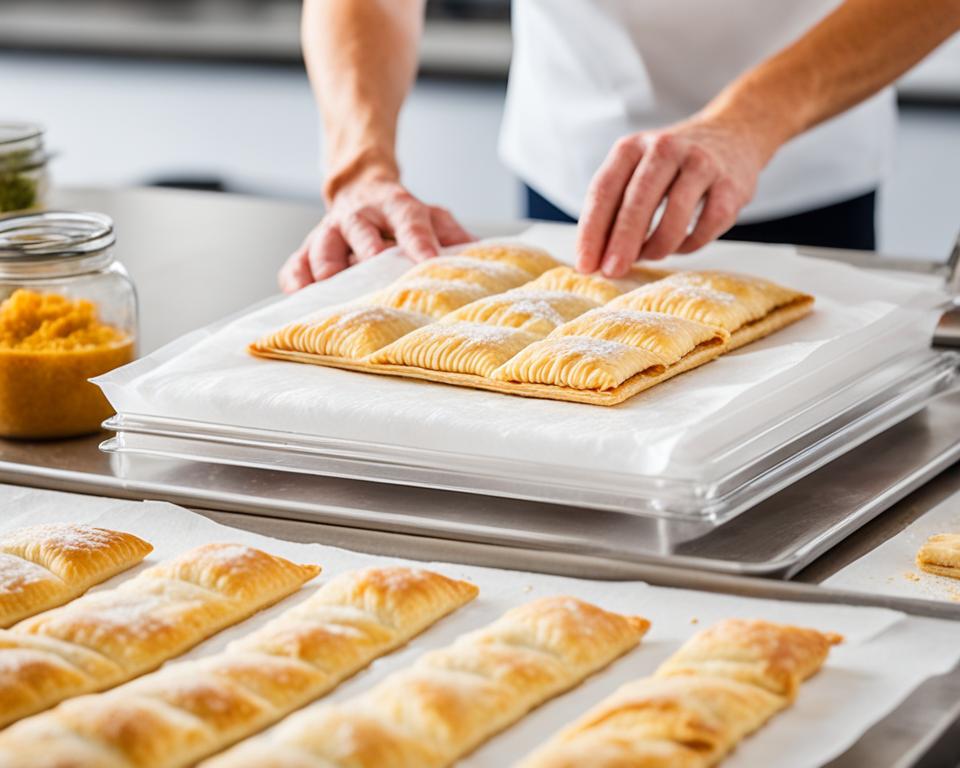
Avoiding Common Mistakes in Pastry Storage
To keep the flaky texture of puff pastry intact, bakers must avoid storing warm pastries in airtight containers, as this could trap steam and result in a soggy texture. Contrary to intuition, letting the pastry cool completely in the open air helps preserve its crispness before moving forward with proper storage methods.
| Mistake | Consequence | Correct Technique |
|---|---|---|
| Sealing warm pastries | Creates steam, softens layers | Allow pastries to cool completely |
| Storing in damp places | Moisture affects crispness | Keep in a dry, cool environment |
| Overpacking pastries together | Crushes flaky layers | Store flat in single layers |
Best Practices for Freezing and Thawing Dough
Freezing puff pastry is a practical option for extended preservation. To avoid freezer burn, diligently double-wrap your pastry dough before freezing. This defense encases the dough away from harsh cold air, locking in quality. Additionally, when the time comes to thaw, patience is key. Always thaw dough in the fridge, not at room temperature, to prevent dough from becoming brittle or breaking.
| Freezing | Thawing |
|---|---|
| Double-wrap dough for protection | Thaw dough in fridge overnight |
| Label packaging with date | Do not unfold dough until fully thawed |
Remember, these pastry tips are designed to optimize the flaky quality of your puff pastry, whether you’re keeping it at room temperature or freezing puff pastry for future feasts. Following these guidelines, you can ensure every pastry retains the right to be called puff-perfect.
Savory vs. Sweet Puff Pastry Applications
The remarkable duality of puff pastry lies in its chameleon-like quality to pair beautifully with a variety of flavors, whether they fall on the savory or sweet spectrum of taste. The flakiness and delicate layers created by precisely folded, cold butter bits form an impeccable canvas for versatile pastry recipes. This is where culinary artistry comes to play, enabling bakers to craft an array of exquisite dishes that speak to individual palates and occasions.
On the savory side, savory puff pastry delights, such as ham and cheese roll-ups, encapsulate sophistication in a bite-sized form. They are ideal for entertaining, inviting a communal experience where guests can savor the golden, crispy texture married exquisitely to the rich, melted cheese and savory ham. Similarly, these versatile pastries can envelop an assortment of ingredients – from spinach and feta to caramelized onions and goat cheese – all benefiting from the unmistakable flaky puff pastry base that puffs into golden perfection in the oven.
Transitioning to the sweeter realm, sweet puff pastry provides an equally splendid groundwork for confectionary delights. Imagine biting into decadent pear, walnut, and chocolate chip crescents, where the sweetness of ripe pear harmonizes with the earthy crunch of walnuts and the richness of melted chocolate, all wrapped within the tender embrace of a flaky pastry. The versatility continues as these sweets can easily take on the seasonal freshness of summer berries or the spiced warmth of autumnal apples, transforming the puff pastry into festive desserts or indulgent breakfasts.
The alchemy of turning simple, cold butter and dough into such diverse and intricate culinary creations is the true magic of baking with puff pastry.
Below is a table detailing the popular options for sweet and savory fillings, capturing the versatility of these pastries. Each matching is curated to enhance the delicate, flaky texture of puff pastry, opening up a world of possibilities for the home baker.
| Savory Filling Ideas | Sweet Filling Ideas |
|---|---|
| Cheese & Onion | Fruit & Nutella |
| Garlic Mushrooms & Thyme | Lemon Curd & Blueberries |
| Pepperoni & Marinara | Almond Paste & Poached Pears |
| Ratatouille Vegetables | Spiced Apples & Caramel |
Furthermore, the adaptability of puff pastry extends to cultural cuisines. It can be used to recreate a Greek Spanakopita, an Argentine Empanada, or even an Indian Samosa, each dish bringing forward the beloved flaky texture for a global culinary tour.
Such a myriad of fillings illustrate puff pastry’s role as a versatile pastry recipe champion. Straddling the line between savory and sweet, these fillings showcase puff pastry’s remarkable ability to transform, creating tailored experiences that are enjoyed by any and all who appreciate the art of flaky layered pastries.
Innovative Flaky Puff Pastry Twists and Variations
Exploring the limitless possibilities with flaky puff pastry, bakers can venture into creating unique pastry creations that blend traditional techniques with modern twists. This versatility not only broadens the horizons of what can be achieved in one’s own kitchen but also infuses global gastronomy into everyday baking, embracing international cuisine for delectable results.
Pairing Flavors for Unique Puff Pastry Creations
Pairing flavors for unique pastry creations allows home bakers to experiment and tailor their recipes to desired taste profiles. Whether it’s the contrast of savory and sweet or the harmony of herbs and cheeses, these innovations lead to mouthwatering pastries ripe for sharing.
From incorporating caramelized onions and creamy goat cheese to experimenting with ripened pear and Gorgonzola, the flaky puff pastry twists become a canvas for creativity. Each ingredient adds a layer of flavor just as each fold adds a layer of texture, resulting in both a visual and gustatory work of art.
Infusing International Cuisine into Your Pastries
The adaptability of puff pastry opens the door to international cuisine, where one can take a culinary journey around the world with just a few variations. With an ear to global trends and a palate for exploration, the flaky dough becomes a medium for cultural expression.
| Cuisine | Ingredients | Inspired Puff Pastry Creation |
|---|---|---|
| Italian | Prosciutto, Fig, Mascarpone | Prosciutto and Fig Puff Twists with Mascarpone Dip |
| Middle Eastern | Spiced Lamb, Feta, Mint | Lamb-Filled Puff Pastries with Feta-Mint Topping |
| South American | Beef, Chilies, Cilantro | Beef Empanada Puff Pastries with Cilantro Drizzle |
| Asian | Teriyaki Chicken, Scallions, Sesame | Teriyaki Chicken Puff Pockets with Sesame Sprinkle |
The table above encapsulates the essence of delicious pastries that borrow from diverse gastronomies. By infusing international flavors—from the tantalizing spices of the Middle East to the rich, savory boldness of South American cuisine—bakers elevate the humble puff pastry to a gastronomic delight that spans the world’s palette.
Puff Pastry Sheets: Pre-made vs. Homemade
When it comes to creating flaky puff pastry, the debate between using pre-made puff pastry sheets and crafting your own homemade pastry exists for both seasoned bakers and culinary newcomers alike. The choice deeply affects the taste, texture, and overall satisfaction of your pastry experience. While puff pastry sheets that are pre-made offer the convenience of being baking-ready, they may fall short compared to the superior flavor and texture of a homemade pastry.
| Aspect | Pre-made Puff Pastry | Homemade Puff Pastry |
|---|---|---|
| Convenience | High – ready to use | Low – requires preparation |
| Taste | Standardized, less distinct | Rich, buttery, customizable |
| Texture | Uniform, can lack flakiness | Exceptionally flaky, airy |
| Flexibility | Limited by shelf-life | Adaptable, can be frozen or used immediately |
The hands-on process of making flaky puff pastry from scratch allows bakers to monitor ingredient quality, from picking the finest butter to ensuring the water is ice-cold, factors that are pivotal in achieving the light and crisp layers that pastry aficionados cherish. Moreover, there’s a certain sense of accomplishment and pride that comes from layering the dough, knowing each fold is a personal touch contributing to the pastry’s final delectable outcome.
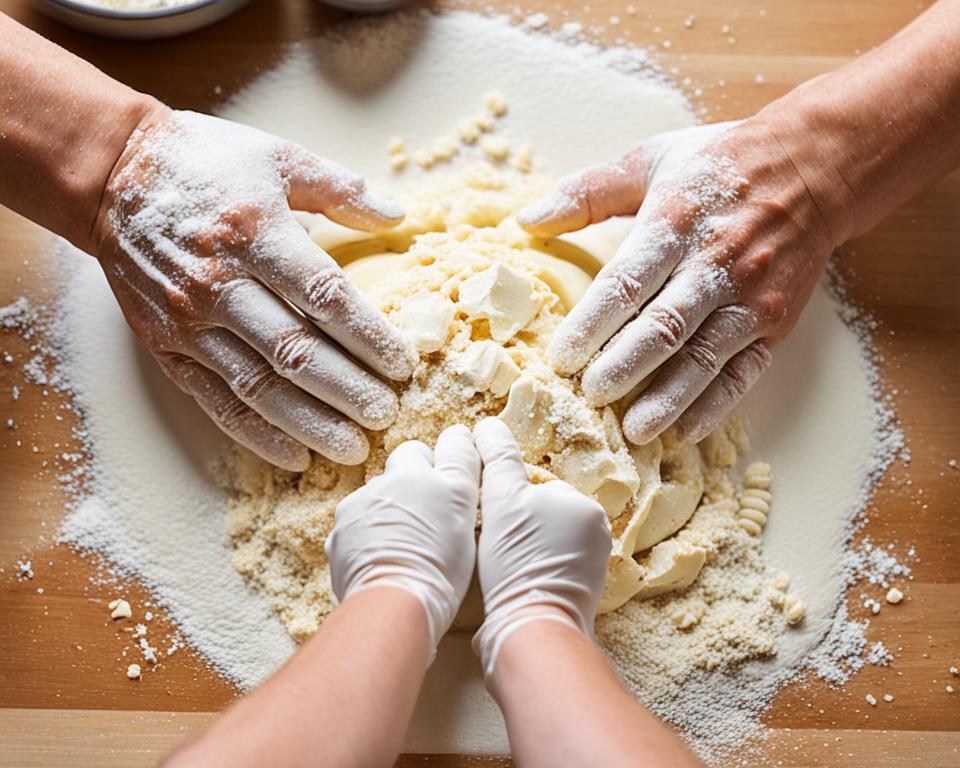
Undoubtedly, using pre-made puff pastry sheets can save time, a priceless commodity for many. However, for those who revere the craft of baking, the allure of a homemade pastry lies not only in the more vibrant flavor and luxurious texture but also in the flexibility it offers. Whether it’s scheduling baking around a busy week, desiring to freeze for later use, or simply taking joy in the process, homemade pastry accommodates a baker’s rhythm and creative flair.
Thus, while convenient, pre-made puff pastry may lack the nuanced layers and indulgent taste that come with a carefully constructed homemade pastry. For bakers willing to invest the time, the homemade method enhances the culinary experience, providing a sensory treat that is both remarkable in flavor and resplendent in texture.
Conclusion
The quest to create the perfect flaky puff pastry is an art form in itself, embedded in a rich tradition of crafting delicate, buttery layers that puff into airy perfection. Home bakers in pursuit of the best puff pastry recipes know that quality and method go hand in hand—selecting premium ingredients and meticulously following time-honored folding procedures are essential. Yet, what makes the process profoundly remarkable is its rewarding nature; a well-executed homemade puff pastry is a vessel of endless culinary exploration and an invitation to a world of delicious pastries.
By adopting homemade pastry tips, such as keeping the butter ice-cold and refraining from overworking the dough, any home kitchen can be transformed into a replica of a Parisian bakery, emitting the same tantalizing aromas and producing pastries just as visually alluring. The convergence of the chosen flour’s quality, the temperature precisely maintained, and the hand’s gentle folding culminate in the birth of a flaky puff pastry that is both an ode to tradition and a canvas for creativity.
In conclusion, whether you are a seasoned baker or a curious novice inspired to craft your version of a patisserie staple, take pride in the journey from flour to finished delight. The homemade path to puff pastry perfection amplifies the essence of baking from scratch: the flavors are more pronounced, the texture more intricate, and the satisfaction unparalleled. Mastery of these techniques assures that whatever your hands create will not just be good but will carry the mark of authentic, irresistible excellence—a testament to your skillful dedication to the art of pastry.
FAQ
What is the “Rough Puff” method and how does it differ from traditional puff pastry making?
The “Rough Puff” method is an alternative technique for making flaky puff pastry, which simplifies the traditional process by skipping yeast and extensive laminating. It calls for large pieces of cold butter to be incorporated into the dough, which is then folded and rolled to create layers. This method is quicker than the traditional one and still produces deliciously buttery and flaky pastries.
Why is temperature control so crucial in making flaky puff pastry?
Temperature control is critical in puff pastry making because cold butter is necessary to create the pastry’s flaky layers. The butter must remain solid until the baking stage, where it melts to create steam that lifts the dough, forming light and airy layers. Inadequate temperature control can lead to a pastry that’s not as flaky or layered.
Can I use any type of butter for puff pastry, or is there a specific kind that works best?
For the best results in puff pastry, it’s recommended to use cold, high-quality butter, particularly high-fat European styles. These butters have a lower water content, which contributes to better flakiness and layer development in the pastry.
How do I properly fold my puff pastry dough?
Proper folding involves rolling out the dough and executing a series of folds similar to folding a business letter. This creates multiple layers of butter and dough, which is essential for the flakiness of the final product. The folding should be done gently to maintain distinct layers and avoid overworking the dough, which can result in fewer layers and a tougher pastry.
Is yeast necessary for making flaky puff pastry?
No, yeast is not necessary for making flaky puff pastry. The rise in the pastry is achieved mechanically with the steam created by the melting butter during baking, rather than through the biochemical gas release from yeast. This makes the process simpler and the outcome just as light and flaky.
What are the visual cues for knowing when my puff pastry is perfectly baked?
Perfectly baked puff pastry should have a golden-brown hue and a puffed-up, airy appearance. Baking until achieving these visual cues ensures that the pastry has fully developed its flaky layers and has reached the desired crispness.
How do I store puff pastry after baking to maintain its flaky texture?
To maintain the flaky texture after baking, allow puff pastry to cool completely before storing. Seal it in an airtight container or wrap it properly to prevent moisture loss. If the pastry is still warm, avoid sealing it tightly to prevent steam from softening the layers.
What are some savory and sweet applications for homemade flaky puff pastry?
Homemade flaky puff pastry is suitable for both savory and sweet dishes. Savory applications include items like meat and cheese filled turnovers or quiches, while sweet options can range from fruit tarts to cream-filled pastries. The balance of a neutral buttery crust works beautifully with a variety of fillings and toppings.
How can I experiment with international flavors in my puff pastry recipes?
You can experiment with international flavors by incorporating specific ingredients typical to various cuisines. Adding spices, herbs, cheeses, or sweets from different culinary traditions can infuse your puff pastry creations with global flair.
What’s the difference between using pre-made puff pastry sheets and making my own?
The main difference between pre-made puff pastry sheets and homemade is in taste and texture. Homemade puff pastry, made with attention to the quality and handling of ingredients, usually offers more flavor complexity and a more pronounced flakiness. While pre-made sheets are convenient, they may not match the rustic appeal and satisfaction of homemade puff pastry.

